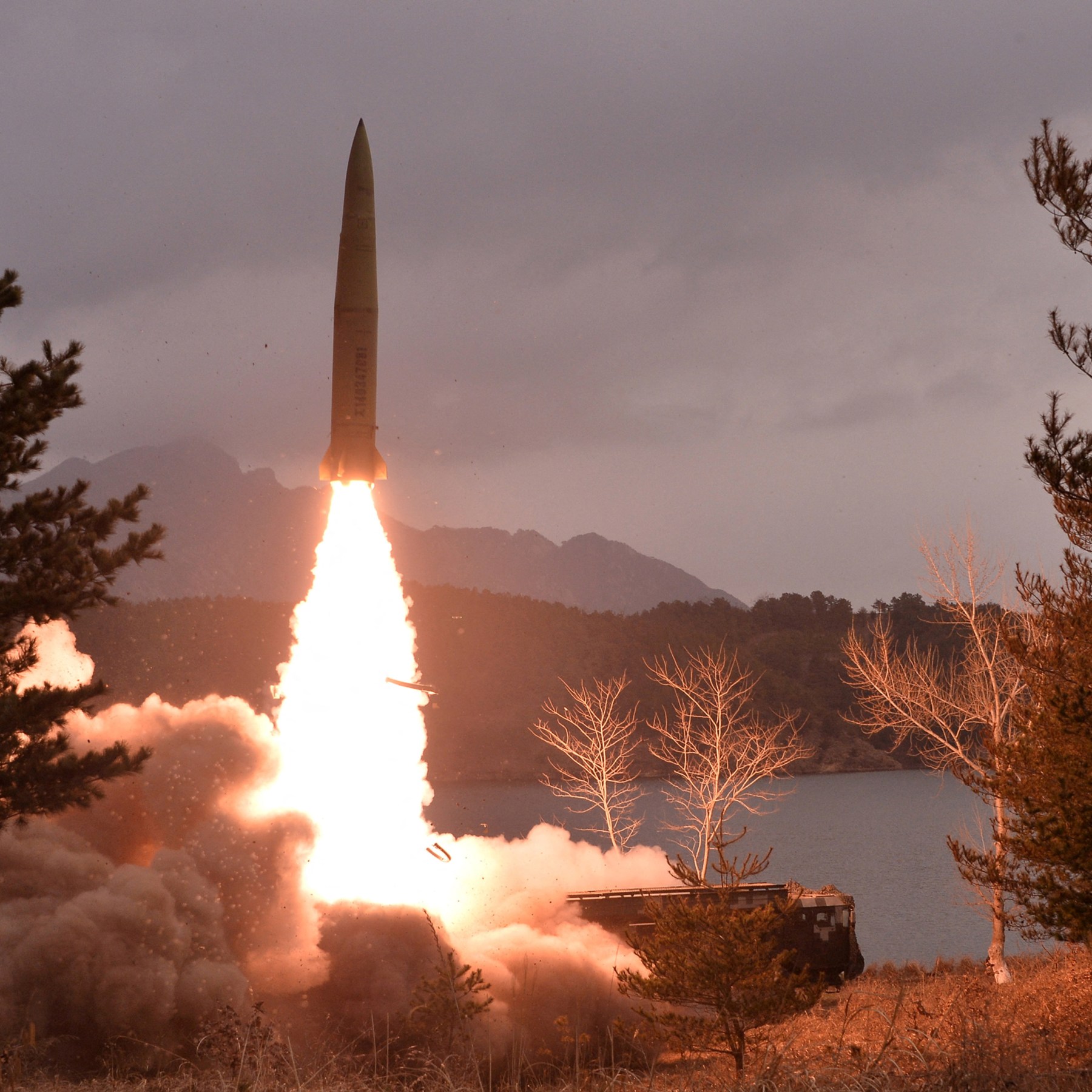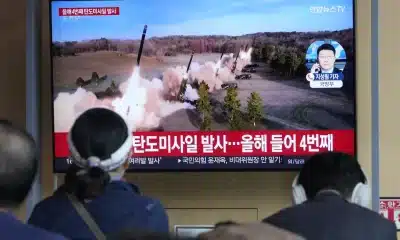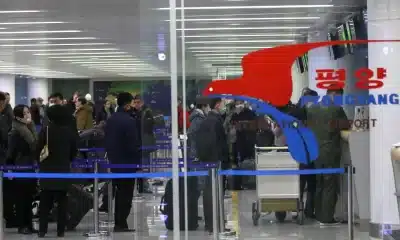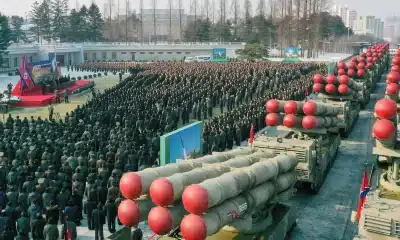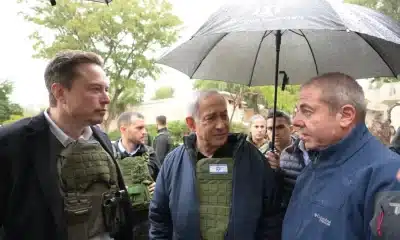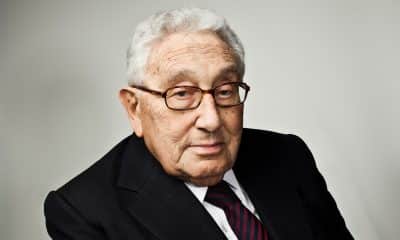World
North Korea Test-Fires 2 More Missiles As US Sends Carrier
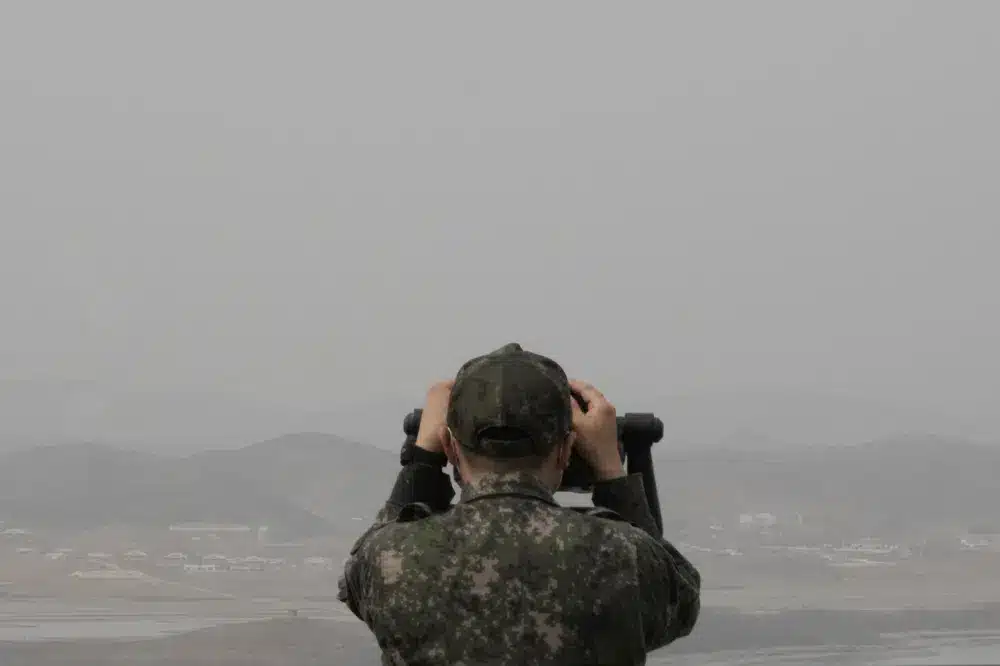
South Korea’s SEOUL — On Monday, the nuclear-powered USS Nimitz and her battle group began operations with South Korean warships, hours after North Korea fired two short-range ballistic missiles in apparent protest of the allies’ growing maneuvers.
This month’s seventh missile test heightened regional tensions as the North’s weapons tests and joint military exercises between the United States and South Korea intensified in a cycle of tit-for-tat.
The launches could have been timed to coincide with the arrival of the USS Nimitz and its strike group, which included a guided missile cruiser and two destroyers and participated in air defense exercises and other maneuvers with South Korean vessels waters around Jeju Island.
South Korean navy spokesperson Jang Do Young said the drills were aimed at honing joint operational capabilities and proving the U.S. resolve to defend its ally with all available options, including nuclear, in the wake of the North’s “escalating nuclear and missile threats.”
On Tuesday, the Nimitz strike group was scheduled to arrive in Busan’s South Korean mainland port.
“The United States has deployable strategic assets at the ready every day,” said Carrier Strike Group Eleven leader Rear Adm. Christopher Sweeney. “We can and will continue to deploy those assets.”
The two North Korean missiles were launched from a western inland area
The two North Korean missiles were launched from a western inland area south of Pyongyang between 7:47 a.m. and 8 a.m. and traveled approximately 370 kilometers (229 miles) before falling at sea, according to South Korea’s Joint Chiefs of Staff. The missiles, which landed beyond Japan’s exclusive economic zone, traveled on an erratic trajectory and reached a maximum altitude of 50 kilometers, according to Japan’s military. (31 miles).
Previously, Japan used similar wording to describe a North Korean solid-fuel missile that appears to be modeled after Russia’s Iskander mobile ballistic weapon, which is supposed to be maneuverable in low-altitude flight to better elude South Korean missile defenses. North Korea also has another short-range system similar to the MGM-140 Army Tactical Missile System used by the United States.
Hirokazu Matsuno, Japan’s Chief Cabinet Secretary, stated that North Korea might increase its testing activity by launching additional missiles or conducting its first nuclear test since September 2017.
The South Korean and Japanese militaries condemned the new launches as a severe provocation endangering regional peace and stated that they were cooperating with the U.S. to further evaluate the missiles. The U.S. Indo-Pacific Command stated that while the launches did not constitute an imminent threat to the U.S. or its allies, they underscore North Korea’s “destabilizing impact” of its illicit nuclear and missile programs.
North Korea, subject to U.N. Security Council sanctions for its nuclear program since 2016
North Korea, subject to U.N. Security Council sanctions for its nuclear program since 2016, did not immediately respond to the launches.
Last week, the U.S. and South Korea concluded their largest springtime drills in years, including computer simulations and live-fire field exercises. However, the allies have continued their field training as a show of force against the mounting dangers from the North.
North Korea also launched a short-range missile when the USS Ronald Reagan and its battle group arrived in September for joint drills with South Korea, the last time the U.S. sent an aircraft carrier to waters near the Korean Peninsula.
North Korea has launched more than 20 ballistic and cruise missiles this year to push the U.S. to accept its nuclear status and negotiate sanctions relief from a position of strength.
This month’s tests included an intercontinental ballistic missile and a series of short-range missiles designed to overwhelm South Korean defenses as North Korea attempts to demonstrate its ability to undertake nuclear strikes on South Korea and the United States mainland.
The North conducted a three-day practice last week that claimed to simulate nuclear assaults on South Korean targets.
The country’s leader, Kim Jong Un, has called the joint military exercises between the United States and South Korea “invasion rehearsals.” According to the allies, the exercises are defensive.
The tests included a rumored nuclear-capable underwater drone.
The tests included a rumored nuclear-capable underwater drone, which the North said could unleash a massive “radioactive tsunami” and destroy navy vessels and ports. Analysts questioned whether such a device posed a significant new danger, and Seoul’s Joint Chiefs of Staff warned in a statement Monday that the North Korean allegations were likely “exaggerated and fabricated.”
Following some of its ballistic and cruise missile tests earlier this month, North Korea claimed that those missiles were tipped with dummy nuclear warheads that detonated 600 to 800 meters (1,960 to 2,600 feet) above their sea targets, presenting them as maximum damage heights.
North Korea has already had a record year of weapons testing, launching more than 70 missiles in 2022. It had enacted an escalator nuclear strategy that allows for pre-emptive nuclear strikes in a wide range of scenarios in which it perceives its leadership to be under threat.
“It appears North Korea is practicing, or signaling that it is practicing, the use of nuclear strikes, both preemptive and retaliatory, in various scenarios authorized in its nuclear doctrine,” said Duyeon Kim, a senior analyst at the Center for a New American Security.
“The problem is that continued testing allows Pyongyang to perfect its technology, strengthen its nuclear weapons capability, threaten South Korea and Japan, increase the possibility of miscalculation, which could lead to inadvertent conflict, and accumulate political leverage ahead of future diplomatic talks with Washington.”
Following the North’s confirmation of the drone test on Friday, South Korea’s air force disclosed information about a five-day joint practice with the U.S. last week, which included live-fire displays of air-to-air and air-to-ground weaponry.
According to the air force, the exercise aimed to test precision strike capabilities and reaffirm the credibility of Seoul’s “three-axis” strategy against North Korean nuclear threats. This strategy includes striking potential targets ahead of time, stopping incoming missiles, and taking out the North’s leadership and key military facilities.
SOURCE – (AP)
World
Hamas Official Says Group Would Lay Down Its Arms If An Independent Palestinian State Is Established

ISTANBUL (AP) — A senior Hamas leader informed The Associated Press that the Islamic extremist organization is prepared to accept a ceasefire lasting five years or more with Israel. Additionally, Hamas would disarm and transform into a political party on the condition that an independent Palestinian state be established based on the borders that existed before 1967.
Khalil al-Hayya’s remarks in a Wednesday interview occurred during a deadlock in the ongoing negotiations for a cessation of hostilities in Gaza. The proposition that Hamas would disarm seemed to be a substantial concession by the militant group that is publicly dedicated to the destruction of Israel.
AP – VOR News Image
Hamas Official Says Group Would Lay Down Its Arms If An Independent Palestinian State Is Established
However, it is improbable that Israel would entertain such a possibility. The Israeli government has made a firm commitment to eliminate Hamas after the devastating Oct. 7 strikes that sparked the conflict. Furthermore, the current leadership of Israel strongly opposes the establishment of a Palestinian state on the territories that Israel gained control of during the 1967 Middle East war.
Al-Hayya, a prominent Hamas official who has been involved in discussions for a ceasefire and hostage exchange on behalf of the Palestinian militants, expressed a combination of defiance and conciliation.
Al-Hayya expressed Hamas’ desire to join the Palestine Liberation Organization (PLO), led by the Fatah side, in order to establish a consolidated government for both Gaza and the West Bank during an interview with the AP in Istanbul.
He stated that Hamas would agree to the establishment of an independent Palestinian state in the West Bank and Gaza Strip, with full sovereignty, and the repatriation of Palestinian refugees in compliance with international agreements. This would be based on Israel’s borders before the 1967 war.
He stated that Should that occur, the group’s military faction would disband.
“What actions have these forces taken after gaining independence and securing their rights and state, considering the experiences of individuals who fought against occupying forces?” “They have transformed into political parties, and their defensive combat units have transformed into the national army,” he stated.
Throughout the years, Hamas has occasionally adjusted its public stance about the potential establishment of a Palestinian state alongside Israel. However, its political agenda publicly refuses to consider any other option but the complete liberation of Palestine, encompassing the territory extending from the Jordan River to the Mediterranean Sea, which includes the regions currently occupied by Israel.
Al-Hayya did not clarify if his seeming acceptance of a two-state solution would lead to a resolution of the Palestinian-Israeli issue or serve as a temporary measure toward the group’s ultimate objective of annihilating Israel.
Ophir Falk, a foreign policy adviser to Israeli Prime Minister Benjamin Netanyahu, refrained from providing a response to Al-Hayya’s remarks, categorizing him as a “prominent terrorist.” However, he stated that Hamas had violated a previous ceasefire by launching an onslaught on southern Israel on Oct. 7, resulting in the deaths of over 1,200 individuals, primarily civilians. Approximately 250 hostages were forcibly taken by militants into the enclave.
According to local health experts, Israel’s subsequent intense bombing and ground attack have resulted in the deaths of over 34,000 Palestinians, with the majority being women and children. Additionally, this has led to the displacement of almost 80% of Gaza’s population, which amounts to 2.3 million people.
“The government led by Prime Minister Netanyahu has undertaken a mission to completely eliminate Hamas’ military and governing abilities in Gaza, liberate the hostages, and guarantee that Gaza will not pose a danger to Israel and the rest of the civilized world in the coming times,” he stated. “The attainment of those objectives is assured.”
The PLO and the Fatah-led Palestinian Authority, which is the internationally recognized self-governing body that Hamas expelled from Gaza in 2007, did not respond immediately. This happened a year after Hamas won the Palestinian legislative elections. Following the Hamas takeover of Gaza, the Palestinian Authority was tasked with governing semi-autonomous areas of the Israeli-occupied West Bank.
The Palestinian Authority aspires to build a sovereign state in the West Bank, east Jerusalem, and Gaza, which Israel seized during the 1967 Mideast conflict. Although most of the world community strongly backs a two-state solution, Netanyahu’s uncompromising administration opposes it.
The ceasefire discussions in Gaza have reached an impasse after almost seven months of conflict. Israel is currently making arrangements for a military operation in the southern city of Rafah, which has become a refuge for over 1 million Palestinians.
Israel claims to have dissolved the majority of the original twenty-four Hamas battalions since the beginning of the conflict. However, it states that four battalions are still surviving and are currently located in Rafah. Israel contends that launching a Rafah attack is vital to secure a decisive triumph over Hamas.
AP – VOR News Image
Hamas Official Says Group Would Lay Down Its Arms If An Independent Palestinian State Is Established
Al-Hayya expressed that such a military operation would not be successful in completely eradicating Hamas. According to him, there is continuous communication between the political leadership outside of Gaza and the military leadership inside Gaza during the conflict. They consult with each other to make decisions and give directives.
The Israeli troops had only managed to incapacitate less than 20% of Hamas’ capabilities, both in terms of personnel and equipment, according to his statement. “If they are unable to completely defeat Hamas, what is the resolution?” The resolution lies in reaching an agreement.
In November, a seven-day period of temporary cessation of hostilities resulted in the liberation of over 100 captives in return for the release of 240 Palestinian detainees detained in Israel. However, negotiations for a lasting ceasefire and the liberation of the remaining captives are currently at a standstill, as both parties are accusing each other of being uncompromising. The primary participant, Qatar, has recently stated that it is thoroughly evaluating its position as a mediator.
The majority of Hamas’ prominent political figures, who were previously situated in Qatar, left the Gulf nation last week and journeyed to Turkey. In Turkey, Hamas’ political leader Ismail Haniyeh met with Turkish President Recep Tayyip Erdogan on Saturday. Al-Hayya refuted the possibility of relocating the group’s primary political office permanently and expressed Hamas’ desire for Qatar to continue serving as a mediator in the negotiations.
Israeli and U.S. officials have alleged that Hamas lacks sincerity in pursuing a compromise.
Al-Hayya refuted this claim, asserting that Hamas has indeed made compromises about the desired quantity of Palestinian detainees to be released in return for the remaining Israeli captives. According to him, the gang lacks precise information regarding the number of hostages that are now in Gaza and are still alive.
However, he stated that Hamas will not yield on its demands for a lasting cessation of hostilities and complete departure of Israeli forces, both of which Israel has refused to accept. Israel has declared its intention to persist with military operations until Hamas is decisively vanquished and will maintain a security presence in Gaza after that.
AP – VOR News Image
Hamas Official Says Group Would Lay Down Its Arms If An Independent Palestinian State Is Established
“Given the lack of guarantee regarding the termination of the war, I see no reason to surrender the prisoners,” stated the Hamas commander in reference to the hostages who are still being held.
Al-Hayya further insinuated that Hamas might launch an attack against Israeli or other forces that may be stationed near a floating dock, which the U.S. is hastily constructing along Gaza’s coastline to provide relief via water.“We firmly refuse any presence in Gaza that is not Palestinian, whether it be at sea or on land, and we will treat any military force in these areas, whether Israeli or from another country, as an occupying force,” he stated.
Al-Hayya stated that Hamas does not feel remorse for the Oct. 7 attacks despite the immense devastation it has inflicted upon Gaza and its inhabitants. He refuted the claim that Hamas terrorists deliberately attacked people during the assaults despite the abundance of compelling evidence suggesting otherwise. Additionally, he asserted that the operation achieved its objective of refocusing global attention on the Palestinian issue.
According to him, Israeli efforts to eliminate Hamas will ultimately prove ineffective in preventing future armed uprisings by Palestinians.
“Suppose they have eradicated Hamas.” “Have the Palestinian people disappeared?” he inquired.
SOURCE – (AP)
World
China Launches 3-Member Crew To Its Space Station As It Seeks To Put Astronauts On The Moon By 2030
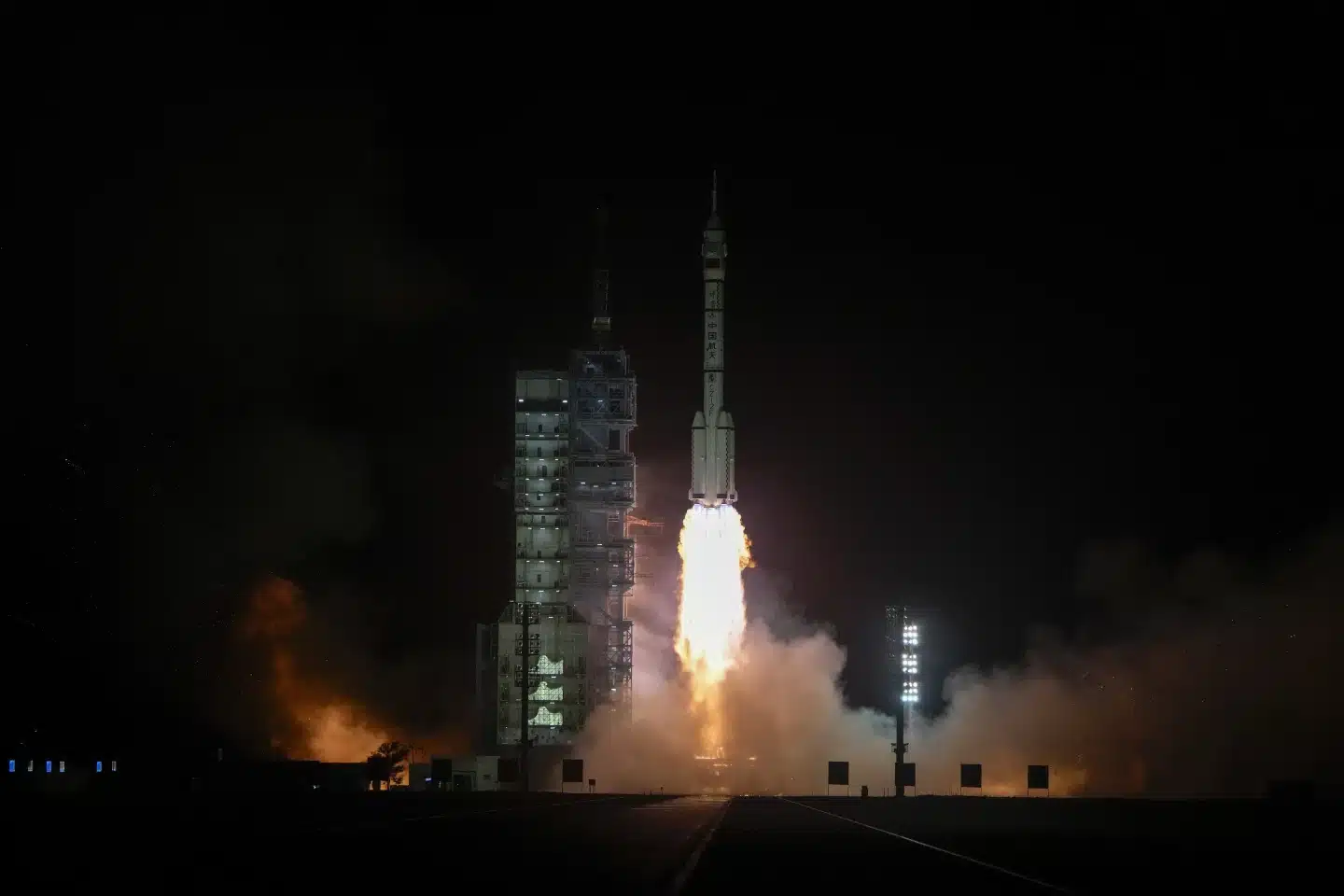
The location is Jiuquan Satellite Launch Center in China. On Thursday, China successfully deployed a three-member crew to its orbiting space station as part of its ambitious initiative to send astronauts to the moon by 2030.
The Shenzhou-18 spacecraft launched from the Jiuquan Satellite Launch Center, located on the periphery of the Gobi Desert in northern China. It was propelled by a Long March 2-F rocket at precisely 8:59 p.m. (1259 GMT).
AP – VOR News Image
China Launches 3-Member Crew To Its Space Station As It Seeks To Put Astronauts On The Moon By 2030
The spacecraft’s three-member crew will replace the Shenzhou-17 team, which has been working aboard China’s Tiangong space station since October last year.
The China Manned Space Agency (CMSA) organized a send-off ceremony for the Shenzhou-18 crew on Thursday. The ceremony included flag-waving youngsters and patriotic music. The three astronauts were getting ready to board the spacecraft.
The trio consists of Commander Ye Guangfu, a seasoned astronaut who participated in the Shenzhou-13 mission in 2021, and two novice spaceflight pilots, Li Cong and Li Guangsu, who are 34 and 36 years old.
Their arrival at the space station is anticipated approximately six-and-a-half hours after the launch.
China constructed its own space station after being denied participation in the International Space Station, primarily due to the United States’ apprehensions regarding the Chinese military’s role in the project. For the current year, the Chinese space station has planned two missions for cargo ships and two for manned spaceflights.
AP – VOR News Image
China Launches 3-Member Crew To Its Space Station As It Seeks To Put Astronauts On The Moon By 2030
The Shenzhou-18 mission will last approximately six months on the space station. According to Lin Xiqiang, deputy director of the CMSA, the crew will conduct scientific testing, install equipment to protect against space debris, undertake payload experiments, and promote science education, among other activities.
In addition, Lin stated that China is actively striving to eventually grant foreign astronauts and space tourists access to its space station.
“During a press conference on Wednesday, he stated that we will expedite the research and promotion of involving foreign astronauts and space tourists in flights on China’s space station.”
The nation is strategizing a mission to retrieve samples from Mars by approximately 2030, along with three lunar probe missions in the upcoming four years. Additionally, it aims to deploy astronauts on the moon by 2030.
In 2003, China successfully carried out its inaugural crewed space mission, making it the third nation, following the former Soviet Union and the United States, to independently send an astronaut into space.
AP – VOR News Image
China Launches 3-Member Crew To Its Space Station As It Seeks To Put Astronauts On The Moon By 2030
Due to its expenditures, supply networks, and capabilities, the U.S. space program will likely maintain a substantial advantage over China’s. Nevertheless, China has made significant advancements in space exploration by successfully retrieving lunar samples after several decades and landing a rover on the relatively unexplored far side of the moon.
The United States has set a goal to return a crew to the moon’s surface by the conclusion of 2025 due to a renewed dedication to manned missions. Private companies like SpaceX and Blue Origin will support this endeavor.
SOURCE – (AP)
World
Satellite Photos Show New Port Construction In Gaza Strip For US-Led Aid Operation
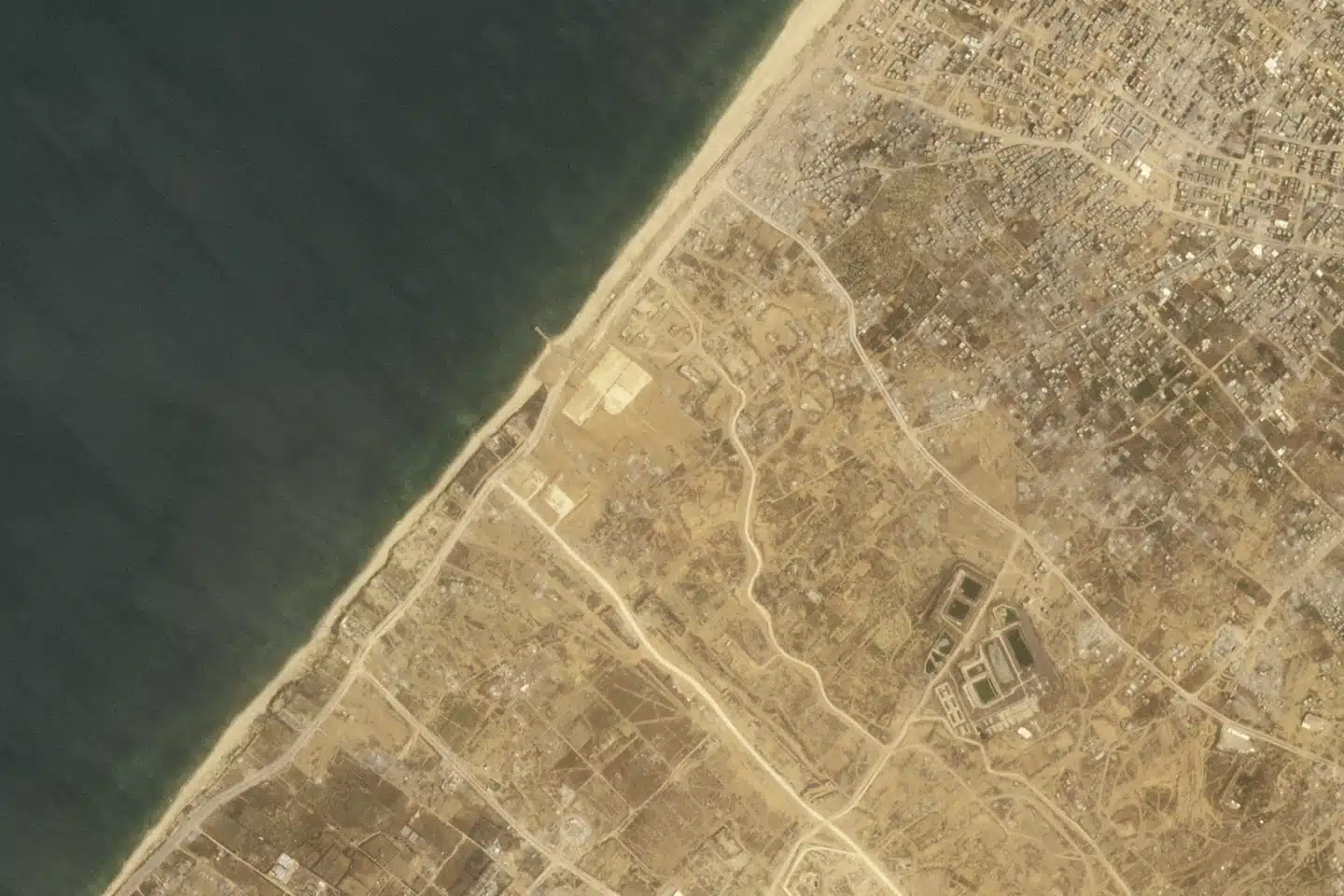
The construction of a new port in the Gaza Strip, in preparation for a U.S. military-led operation to deliver essential food and relief to the besieged enclave during Israel’s ongoing conflict with Hamas, is currently under progress. This information is based on the analysis of satellite pictures conducted by The Associated Press on Thursday.
Based on the photographs, it is evident that the construction has been progressing rapidly in the past two weeks. According to certain officials, the port may be ready for use within a week.

times – VOR News Image
Satellite Photos Show New Port Construction In Gaza Strip For US-Led Aid Operation
The port is located in the southwestern part of Gaza City, which used to be the most densely populated sector in the territory. However, due to the Israeli ground offensive, over 1 million Palestinians were displaced and moved south towards the town of Rafah, which is situated on the Egyptian border. The development of the project occurs while Israel is being heavily criticized internationally for the sluggish distribution of aid in the region. According to the United Nations, a minimum of 25% of the population is in imminent danger of hunger.
Nevertheless, the Israeli military has reported that the facility has already been subjected to a militant mortar bombardment. A representative from the Hamas militant organization, which has governed Gaza since 2007, has cautioned that any foreign military presence at the dock would be susceptible to attack. This may potentially create additional challenges for the relief operations.
The satellite imagery captured by Planet Labs PBC reveals that significant construction activity commenced at the location more than a fortnight ago. The location is located to the north of a road that divides Gaza, which was constructed by the Israeli forces during the conflict.
An anonymous U.N. official stated that the port is located precisely at the terminus of the newly constructed road by the IDF. The official employed an initialism for the Israeli military.
A photograph captured by Planet Labs a week ago revealed the presence of substantial vehicles and machinery, while a more recent image obtained on Wednesday showed that the cleared area had expanded further. A soil embankment acts as a barrier between the area and the adjacent buildings. Additional information corresponds to a visual representation of the help pier observed by the AP.
According to the U.N. official, the port is expected to be divided into three zones. The first zone will be under Israeli control and will be used for dropping off aid from the pier. The second zone will be designated for transferring the aid. The third zone will be where Palestinian drivers, contracted by the U.N., will wait to collect the aid and transport it to distribution points.
However, the official stated that there are still some unresolved issues about the Israeli approach to the security of the port. According to reports, the military is actively pursuing the installation of remotely controllable gun positions, a move that the United Nations is opposing.
AP – VOR News Image
Satellite Photos Show New Port Construction In Gaza Strip For US-Led Aid Operation
According to Israeli officials, Israel will be involved in ensuring the security of the pier and transferring a portion of the supplies from the pier to the coast. However, the exact level of Israel’s intended participation is yet uncertain. Several Israeli government departments failed to provide comments in response to questions regarding the port.
By the end of next week, the pier’s construction will be complete, and as a result, the shipments of aid will resume, according to an anonymous high-ranking official from the Cyprus government who spoke to the AP. The official did not provide a specific timeframe for the commencement of shipments.
Navy personnel have verified, by vessel tracking systems, that the USNS Benavidez, an American cargo ship transporting a significant amount of the heavier equipment required for pier construction, is currently located off the coast of Gaza. Additional naval vessels are present or currently en route to that location.
The dock was subjected to an attack on Wednesday, while four senior U.N. officials were present at the location, causing significant concerns, according to the U.N. official. The military reported that the mortar bombardment initiated by Gaza terrorists compelled the authorities to seek refuge. Nevertheless, no casualties or injuries were incurred.
There was no immediate claim of responsibility from any militant group for the attack.
Nevertheless, Khalil al-Hayya, a prominent Hamas political figure, has stated that if Israeli soldiers or forces from any other nation were deployed at the pier to provide security, Hamas would perceive them as an invading force and an act of aggression.
AP – VOR News Image
Satellite Photos Show New Port Construction In Gaza Strip For US-Led Aid Operation
The port has the potential to significantly impact the situation, as increasing the flow of supplies into Gaza through land crossings has been difficult due to the lengthy queues of vehicles awaiting Israeli inspections. Previous attempts to acquire land via maritime routes were unsuccessful following an assault on a World Central Kitchen convoy transporting aid from a port to a warehouse in central Gaza, resulting in the tragic deaths of seven humanitarian workers.
Nations have resorted to employing the technique of airdropping assistance from the atmosphere, a measure that humanitarian organizations consider as a final option due to its limitations in delivering substantial amounts of relief and its association with fatalities.
SOURCE – (AP)
-
Business5 months ago
Google Will Start Deleting ‘Inactive’ Accounts In December. Here’s What You Need To Know
-
Celebrity5 months ago
Elon Musk Visits Destroyed Kibbutz and Meets Netanyahu in Wake of Antisemitic Post
-
Celebrity5 months ago
Shane MacGowan, Lead Singer Of The Pogues And A Laureate Of Booze And Beauty, Dies At Age 65
-
Entertainment5 months ago
Robert Downey Jr. Won’t Be Returning To The Marvel Cinematic Universe As Tony Stark
-
Politics5 months ago
Former US Secretary Of State Henry Kissinger Dies Aged 100
-
Politics5 months ago
Unveiling the Power and Influence of The Conservative Treehouse


